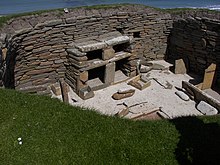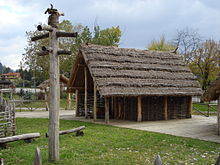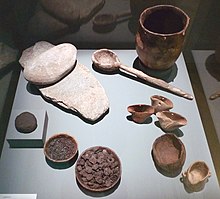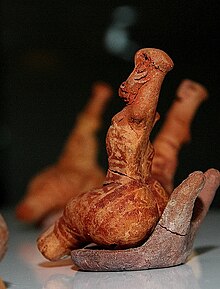This is an old revision of this page, as edited by 68.81.174.30 (talk) at 00:08, 14 January 2010. The present address (URL) is a permanent link to this revision, which may differ significantly from the current revision.
Revision as of 00:08, 14 January 2010 by 68.81.174.30 (talk)(diff) ← Previous revision | Latest revision (diff) | Newer revision → (diff)</ref> Other scholars argue that the primary stimulus for agriculture and domesticated animals (as well as mud-brick architecture and other Neolithic cultural features) in Egypt was from the Middle East.
Europe
]


In southeast Europe agrarian societies first appeared by ca. 7000 BCE, and in Central Europe by ca. 5500 BCE. Among the earliest cultural complexes of this area are included the Sesklo culture in Thessaly , which later expanded in the Balkans giving Starčevo-Körös (Cris), Linearbandkeramic, and Vinča. Through a combination of cultural diffusion and migration of peoples, the Neolithic traditions spread west and northwards to reach northwestern Europe by around 4500 BCE. The Vinča culture may have created the earliest system of writing, the Vinča signs, though it is almost universally accepted amongst archeologists that the Sumerian cuneiform script was the earliest true form of writing and the Vinča signs most likely represented pictograms and ideograms rather than a truly developed form of writing. The Cucuteni-Trypillian culture built enormous settlements in Romania,Lahuradewa]], at Middle Ganges region, C14 dated around 7th millennium BCE. Recently another site near the confluence of the Ganges and Yamuna rivers called Jhusi yielded a C14 dating of 7100 BCE for its Neolithic levels. A new 2009 report by archaeologist Rakesh Tewari on Lahuradewa shows new C14 datings that range between 8000 BCE and 9000 BCE associated with rice, making Lahuradewa the earliest Neolithic site in entire South Asia.
In South India, the Neolithic began by 3000 BCE and lasted until around 1400 BCE when the Megalithic transition period began. South Indian Neolithic is characterized by Ashmounds since 2500 BCE in Karnataka region, expanded later to Tamil Nadu.
In East Asia, the earliest sites include Pengtoushan culture around 7500 BCE to 6100 BCE, Peiligang culture around 7000 BCE to 5000 BCE.
In Mesoamerica, a similar set of events (i.e., crop domestication and sedentary lifestyles) occurred by around 4500 BCE, but possibly as early as 11,000–10,000 BC, although here the term "Pre-Classic" (or Formative) is used instead of mid-late Neolithic, the term Archaic Era for the Early Neolithic, and Paleo-Indian for the preceding period, though these cultures are usually not referred to as belonging to the Neolithic.
Social organization

[[File:later Bronze Age. Although some late Neolithic societies formed complex stratified chiefdoms similar to Polynesian societies such as the Ancient Hawaiians, most Neolithic societies were relatively simple and egalitarian. However, Neolithic societies were noticeably more hierarchical than the Paleolithic cultures that preceded them and Hunter-gatherer cultures in generalCite error: A <ref> tag is missing the closing </ref> (see the help page). Settlements with palisades and weapon-traumatized bones have been discovered, such as at Herxheim, which, whether the site of a massacre or of a martial ritual, demonstrates "...systematic violence between groups." and warfare was probably much more common during the Neolithic than in the preceding Paleolithic period. This supplanted an earlier view of the Linear Pottery Culture as living a "peaceful, unfortified lifestyle."
Control of labour and inter-group conflict is characteristic of corporate-level or 'tribal' groups, headed by a charismatic individual; whether a 'big man', a proto-chief or a matriarch, functioning as a lineage-group head. Whether a non-hierarchical system of organization existed is debatable and there is no evidence that explicitly suggests that Neolithic societies functioned under any dominating class or individual, as was the case in the chiefdoms of the European Early Bronze Age. Theories to explain the apparent implied egalitarianism of Neolithic (and Paleolithic) societies have arisen, notably the Marxist concept of primitive communism.
Shelter

The shelter of the early people changed dramatically from the Paleolithic to the neolithic era. In the paleolithic, people did not normally live in permanent constructions. In the neolithic, mud brick houses started appearing that were coated with plaster. The growth of agriculture made permanent houses possible. Doorways were made on the roof, with ladders positioned both on the inside and outside of the houses. The roof was supported by beams from the inside. The rough ground was covered by platforms, mats, and skins on which residents slept.
Farming
Main article: Neolithic Revolution

A significant and far-reaching shift in human subsistence and lifestyle was to be brought about in areas where crop farming and cultivation were first developed: the previous reliance on an essentially nomadic hunter-gatherer subsistence technique or pastoral transhumance was at first supplemented, and then increasingly replaced by, a reliance upon the foods produced from cultivated lands. These developments are also believed to have greatly encouraged the growth of settlements, since it may be supposed that the increased need to spend more time and labor in tending crop fields required more localized dwellings. This trend would continue into the Bronze Age, eventually giving rise to towns, and later cities and states whose larger populations could be sustained by the increased productivity from cultivated lands.
The profound differences in human interactions and subsistence methods associated with the onset of early agricultural practices in the Neolithic have been called the Neolithic Revolution, a term coined in the 1920s by the Australian archaeologist Vere Gordon Childe.
One potential benefit of the development and increasing sophistication of farming technology was an ability (if conditions allowed) to produce a crop yield that would be surplus to the immediate needs of the community. When such surpluses were produced they could be preserved and sequestered for later use during times of seasonal shortfalls, traded with other communities (giving rise to a nascent non-subsistence economy), and in general allowed larger populations to be sustained. The storage site might need to be defended from marauders, increasing the cultural investment in a particular site.
However, early farmers were also adversely affected in times of famine, such as may be caused by drought or pests. In instances where agriculture had become the predominant way of life, the sensitivity to these shortages could be particularly acute, affecting agrarian populations to an extent that otherwise may not have been routinely experienced by prior hunter-gatherer communities. Nevertheless, agrarian communities generally proved successful, and their growth and the expansion of territory under cultivation continued.
Another significant change undergone by many of these newly-agrarian communities was one of diet. Pre-agrarian diets varied by region, season, available local plant and animal resources and degree of pastoralism and hunting. Post-agrarian diet was restricted to a limited package of successfully cultivated cereal grains, plants and to a variable extent domesticated animals and animal products. Supplementation of diet by hunting and gathering was to variable degrees precluded by the increase in population above the carrying capacity of the land and a high sedentary local population concentration. In some cultures, there would have been a significant shift toward increased starch and plant protein. The relative nutritional benefits and drawbacks of these dietary changes, and their overall impact on early societal development is still debated.
In addition, increased population density, decreased population mobility, increased continuous proximity to domesticated animals, and continuous occupation of comparatively population-dense sites would have altered sanitation needs and patterns of disease.
Technology


Neolithic peoples were skilled farmers, manufacturing a range of tools necessary for the tending, harvesting and processing of crops (such as sickle blades and grinding stones) and food production (e.g. pottery, bone implements). They were also skilled manufacturers of a range of other types of stone tools and ornaments, including projectile points, beads, and statuettes. But what allowed forest clearance on a large scale was the polished stone axe above all other tools. Together with the adze, fashioning wood for shelter, structures and canoes for example, this enabled them to exploit their newly won farmland.
Neolithic peoples in the Levant, Anatolia, Syria, northern Mesopotamia and Central Asia were also accomplished builders, utilizing mud-brick to construct houses and villages. At Çatal höyük, houses were plastered and painted with elaborate scenes of humans and animals. In Europe, long houses built from wattle and daub were constructed. Elaborate tombs were built for the dead. These tombs are particularly numerous in Ireland, where there are many thousand still in existence. Neolithic people in the British Isles built long barrows and chamber tombs for their dead and causewayed camps, henges, flint mines and cursus monuments. It was also important to figure out ways of preserving food for future months, such as fashioning relatively airtight containers, and using substances like salt as preservatives.
The peoples of the Americas and the Pacific mostly retained the Neolithic level of tool technology until the time of European contact. Exceptions include few copper hatchets and spear heads in the Great Lakes region. However, there are numerous examples of development of complex socio-political organization, building technology, scientific knowledge and linguistic culture in these regions that parallel post-neolithic developments in Africa and Eurasia. Those include the Inca, Maya, ancient Hawaii, Aztec, Iroquois, Mississippian and Māori.
Clothing
Most clothing appears to have been made of animal skins, as indicated by finds of large numbers of bone and antler pins which are ideal for fastening leather, but not cloth. However, woolen cloth and linen might have become available during the British Neolithic, as suggested by finds of perforated stones which (depending on size) may have served as spindle whorls or loom weights. The clothing worn in the Neolithic Age might be similar to that worn by Ötzi the Iceman, although he was not British and not Neolithic (since he belonged to the later Copper age).
Early settlements

Neolithic human settlements include:
- Tabon Cave Complex in Quezon, Palawan, Philippines 5000 – 2000 BCE
- Spirit Cave in Thailand, 9000 – 5500 BCE
- Padah-Lin Caves in Myanmar, ca 11000 BCE
- Franchthi Cave in Greece, epipalaeolithic (ca. 10000 BCE) settlement, reoccupied between 7500–6000 BC
- Göbekli Tepe in Turkey, ca. 9000 BCE
- Jericho in West bank, Neolithic from around 8350 BCE, arising from the earlier Epipaleolithic Natufian culture
- [[Nevali
- Paleolithic
|}
Footnotes
- Aikhenvald, Alexandra Y; RMW Dixon Areal Diffusion and Genetic Inheritance: Problems in Comparative Linguistics p.35
- Hassan, Fekri Droughts, Food and Culture: books.google.co.uk/books?id=kVJwQsZUwxYC&pg=PA164&dq=early+agriculture+Fayum&as_brr=3&cd=5#v=onepage&q=early%20agriculture%20Fayum&f=false]
- Shillington, Kevin Encyclopedia of African History Routledge; 1 edition (18 Nov 2004) ISBN 978-1579582456 p.521
- Female figurine, circa 6000 BC, Nea Nikomidia, Macedonia, Veroia, (Archaeological Museum), Greece
- Fuller, Dorian 2006. "Agricultural Origins and Frontiers in South Asia: A Working Synthesis" in Journal of World Prehistory 20, p.42 "Ganges Neolithic"
- Tewari, Rakesh et al. 2006. "Second Preliminary Report of the excavations at Lahuradewa,District Sant Kabir Nagar, UP 2002-2003-2004 & 2005-06" in Pragdhara No. 16 "Electronic Version p.28"
- Killen, pg 422.
- Cite error: The named reference
Leonard D. Katz Rigby 2000 352was invoked but never defined (see the help page). - "Stone Age," Microsoft Encarta Online Encyclopedia 2007 © 1997–2007 Microsoft Corporation. All Rights Reserved. Contributed by Kathy Schick, B.A., M.A., Ph.D. and Nicholas Toth, B.A., M.A., Ph.D. Archived 2009-11-01.
- Krause (1998) under External links, places.
- Orschiedt (2006) under External links, Places.
- Guthrie, pg 422
- Gimbutas (1991) page 143.
- Ian Kuijt (2000) "Life in Neolithic Farming Communities: Social Organization, Identity, and differentiation" page 317 Springer press
- ^ Shane, Orrin C. III, and Mine Küçuk. "The World's First City." Archaeology 51.2 (1998): 43–47.
- Cite error: The named reference
Bahn, Paul 1996was invoked but never defined (see the help page).
Bibliography
- Bellwood, Peter (2004). First Farmers: The Origins of Agricultural Societies. Wiley-Blackwell. ISBN 0631205667.
- Pedersen, Hilthart (2008), "Die jüngere Steinzeit auf Bornholm", München & Ravensburg. ISBN 978-3638945592
External links
- McNamara, John (2005). "Neolithic Period". World Museum of Man. Retrieved 2008-04-14.
- {{cite web|last=Rincon|first=Paul|title=Brutal